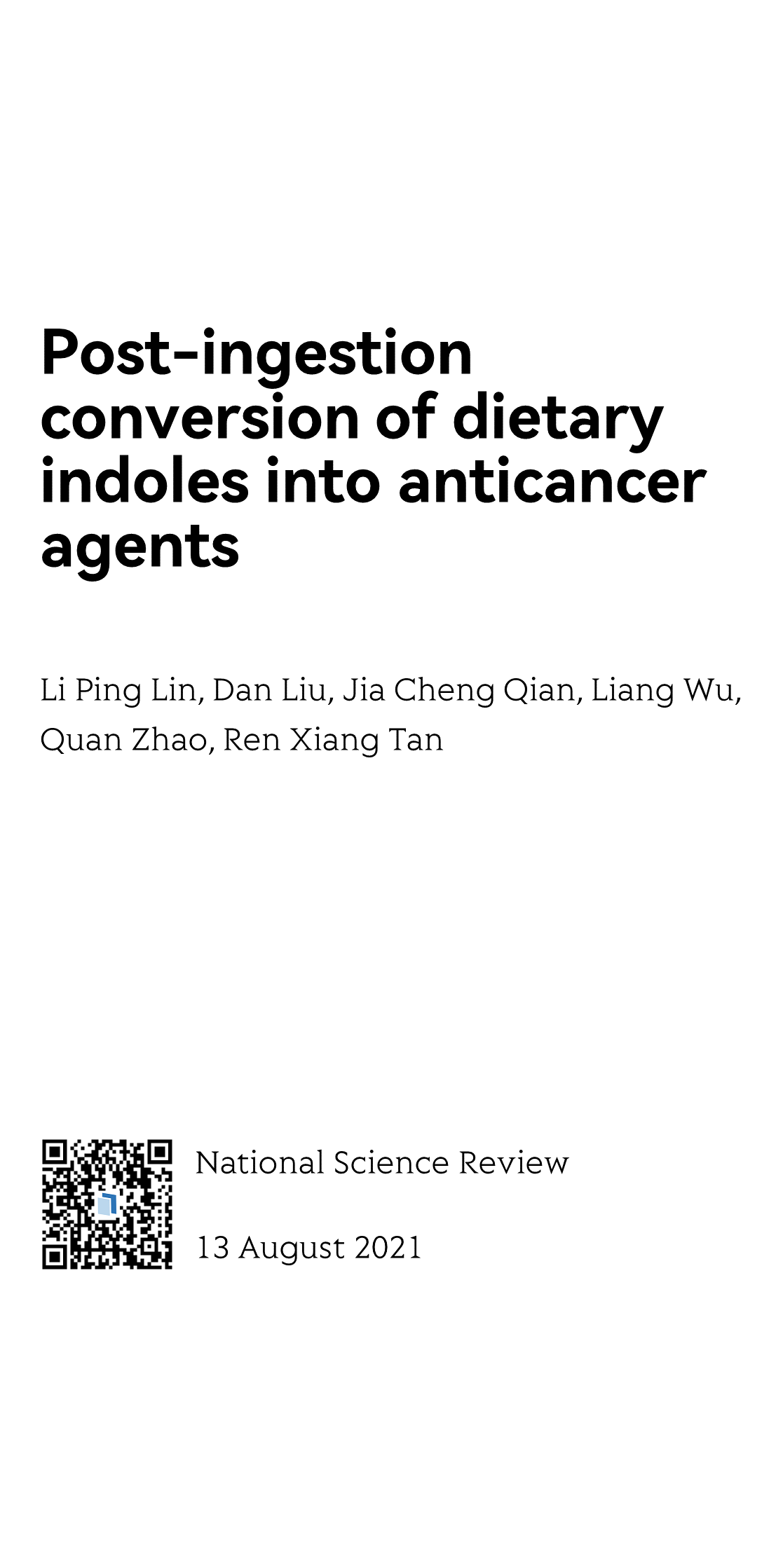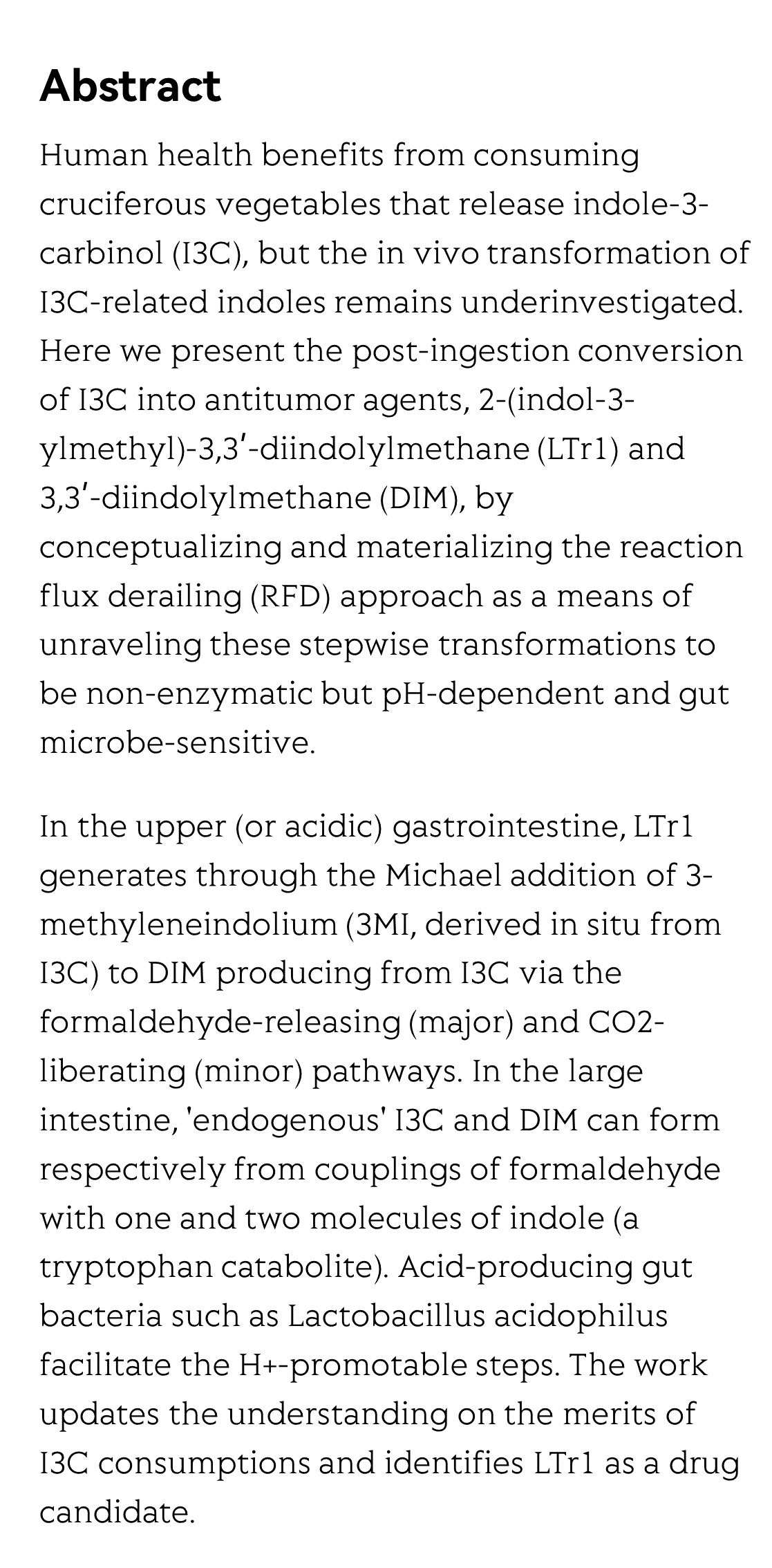(Peer-Reviewed) Post-ingestion conversion of dietary indoles into anticancer agents
Li Ping Lin ¹ ², Dan Liu 刘丹 ², Jia Cheng Qian ², Liang Wu ², Quan Zhao 赵权 ¹, Ren Xiang Tan 谭仁祥 ¹ ²
¹ State Key Laboratory of Pharmaceutical Biotechnology, Institute of Functional Biomolecules, Nanjing University, Nanjing 210023, China 南京大学 功能生物分子研究所 医药生物技术国家重点实验室
² State Key Laboratory Cultivation Base for TCM Quality and Efficacy, Nanjing University of Chinese Medicine, Nanjing 210023, China 南京中医药大学 中药品质与效能国家重点实验室培育点
National Science Review
, 2021-08-13
Abstract
Human health benefits from consuming cruciferous vegetables that release indole-3-carbinol (I3C), but the in vivo transformation of I3C-related indoles remains underinvestigated. Here we present the post-ingestion conversion of I3C into antitumor agents, 2-(indol-3-ylmethyl)-3,3′-diindolylmethane (LTr1) and 3,3′-diindolylmethane (DIM), by conceptualizing and materializing the reaction flux derailing (RFD) approach as a means of unraveling these stepwise transformations to be non-enzymatic but pH-dependent and gut microbe-sensitive.
In the upper (or acidic) gastrointestine, LTr1 generates through the Michael addition of 3-methyleneindolium (3MI, derived in situ from I3C) to DIM producing from I3C via the formaldehyde-releasing (major) and CO2-liberating (minor) pathways. In the large intestine, 'endogenous' I3C and DIM can form respectively from couplings of formaldehyde with one and two molecules of indole (a tryptophan catabolite). Acid-producing gut bacteria such as Lactobacillus acidophilus facilitate the H+-promotable steps. The work updates the understanding on the merits of I3C consumptions and identifies LTr1 as a drug candidate.
Review for wireless communication technology based on digital encoding metasurfaces
Haojie Zhan, Manna Gu, Ying Tian, Huizhen Feng, Mingmin Zhu, Haomiao Zhou, Yongxing Jin, Ying Tang, Chenxia Li, Bo Fang, Zhi Hong, Xufeng Jing, Le Wang
Opto-Electronic Advances
2025-07-17
Multiphoton intravital microscopy in small animals of long-term mitochondrial dynamics based on super‐resolution radial fluctuations
Saeed Bohlooli Darian, Jeongmin Oh, Bjorn Paulson, Minju Cho, Globinna Kim, Eunyoung Tak, Inki Kim, Chan-Gi Pack, Jung-Man Namgoong, In-Jeoung Baek, Jun Ki Kim
Opto-Electronic Advances
2025-07-17
Non-volatile tunable multispectral compatible infrared camouflage based on the infrared radiation characteristics of Rosaceae plants
Xin Li, Xinye Liao, Junxiang Zeng, Zao Yi, Xin He, Jiagui Wu, Huan Chen, Zhaojian Zhang, Yang Yu, Zhengfu Zhang, Sha Huang, Junbo Yang
Opto-Electronic Advances
2025-07-09
CW laser damage of ceramics induced by air filament
Chuan Guo, Kai Li, Zelin Liu, Yuyang Chen, Junyang Xu, Zhou Li, Wenda Cui, Changqing Song, Cong Wang, Xianshi Jia, Ji'an Duan, Kai Han
Opto-Electronic Advances
2025-06-27
Operando monitoring of state of health for lithium battery via fiber optic ultrasound imaging system
Chen Geng, Wang Anqi, Zhang Yi, Zhang Fujun, Xu Dongchen, Liu Yueqi, Zhang Zhi, Yan Zhijun, Li Zhen, Li Hao, Sun Qizhen
Opto-Electronic Science
2025-06-25
Observation of polaronic state assisted sub-bandgap saturable absorption
Li Zhou, Yiduo Wang, Jianlong Kang, Xin Li, Quan Long, Xianming Zhong, Zhihui Chen, Chuanjia Tong, Keqiang Chen, Zi-Lan Deng, Zhengwei Zhang, Chuan-Cun Shu, Yongbo Yuan, Xiang Ni, Si Xiao, Xiangping Li, Yingwei Wang, Jun He
Opto-Electronic Advances
2025-06-19





